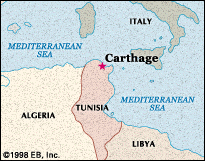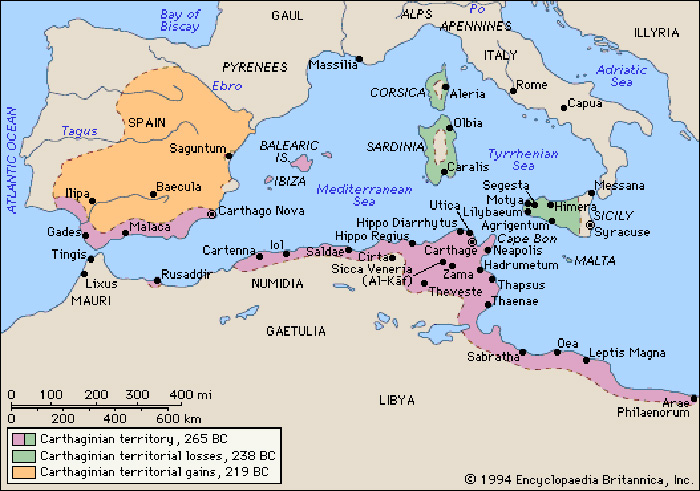Carthage to the Dead Sea
The showdown of the Libya revolution has been widely reported in Japan, too.
Japanese TV stations also reported how Secretary Ms. Clinton responded when she got the news of the death of Col. Gadaffi from a cellular phone.
Yet, my concern is where Gadaffi and his soldiers were heading for from Sirt in the convoy of scores of cars in the early morning.
Anyway, in the sky above the city, some U.S. drones must have been patrolling so intently.
Review of Carthage
Libya was not former Carthage, but it reminds us of the ancient great event around the Mediterranean.
Great city of antiquity, traditionally founded on the north coast of Africa by the Phoenicians of Tyre in 814 B.C. It is now a residential suburb of the city of Tunis. Its Phoenician name means New Town.
 Various traditions concerning the foundation of Carthage were current among the Greeks, who called the city Karchedon; but the Roman tradition is better known because of the Aeneid, which tells of the city's foundation by the Tyrian princess Dido, who fled from her brother Pygmalion (the name of a historical king of Tyre). The inhabitants were known to the Romans as Poeni, a derivation from the word Phoenikes (Phoenicians), from which the adjective Punic is derived.
Various traditions concerning the foundation of Carthage were current among the Greeks, who called the city Karchedon; but the Roman tradition is better known because of the Aeneid, which tells of the city's foundation by the Tyrian princess Dido, who fled from her brother Pygmalion (the name of a historical king of Tyre). The inhabitants were known to the Romans as Poeni, a derivation from the word Phoenikes (Phoenicians), from which the adjective Punic is derived.The date of the foundation of Carthage was probably exaggerated by the Carthaginians themselves, for it does not agree with the archaeological data. Nothing earlier than the last quarter of the 8th century B.C. has been discovered, a full century later than the traditional foundation date.
The site chosen for Carthage in the centre of the shore of the Gulf of Tunis was ideal: the city was built on a triangular peninsula covered with low hills and backed by the Lake of Tunis with its safe anchorage and abundant supplies of fish. The site of the city was well protected and easily defensible. On the south the peninsula is connected to the mainland by a narrow strip of land. The ancient citadel, the Byrsa, was on a low hill overlooking the sea. Some of the earliest tombs have been found there, though nothing remains of Carthage's domestic and public buildings.
The standard of cultural life enjoyed by the Carthaginians was probably far below that of the larger cities of the classical world. Punic interests were turned toward commerce. In Roman times Punic beds, cushions, and mattresses were regarded as luxuries, and Punic joinery and furniture were copied. Much of the revenue of Carthage came from its exploitation of the silver mines of North Africa and southern Spain, begun as early as 800 B.C.
From the middle of the 3rd century to the middle of the 2nd century B.C., Carthage was engaged in a series of wars with Rome. These wars, which are known as the Punic Wars, ended in the complete defeat of Carthage by Rome. When Carthage finally fell in 146 B.C., the site was plundered and burned, and all human habitation there was forbidden.
http://www.thelatinlibrary.com/imperialism/notes/carthage.html
In a more wider view, the situation of the Mediterranean a century after the demise of Alexander the Great:

Phoenicia
Carthage was built by Phoenicians who lived so close to ancient Judaists:
"Phoenicia" is really a Classical Greek term used to refer to the region of the major Canaanite port towns, and does not correspond exactly to a cultural identity that would have been recognised by the Phoenicians themselves. It is uncertain to what extent the Phoenicians viewed themselves as a single ethnicity. Their civilization was organized in city-states, similar to ancient Greece.[5] However in terms of archaeology, language, life style and religion, there is little to set the Phoenicians apart as markedly different from other cultures of Canaan. As Canaanites, they were unique in their remarkable seafaring achievements....
Through their maritime trade, the Phoenicians spread the use of the alphabet to North Africa and Europe, where it was adopted by the Greeks, who later passed it on to the Etruscans, who in turn transmitted it to the Romans....
In 2004, two geneticists who are part of the National Geographic Genographic Project, Pierre Zalloua and Spencer Wells, identified "the haplogroup of the Phoenicians" as haplogroup J2.[12] The male populations of Tunisia and Malta were also included in this study. They were shown to share "overwhelming" genetic similarities with the Lebanese. In 2008, scientists from the Genographic Project announced that "as many as 1 in 17 men living today on the coasts of North Africa and southern Europe may have a Phoenician direct male-line ancestor."

Ancestors of present North Africans are related to Palestine through Carthage, Phoenicia, and Canaanites. But then what about ancient Israelites?
Judea in the 3rd to 2nd Century BC
Ancient Judaists or Israelites did not enjoy glory of their nation around the eras of Alexander the Great and Carthage.
But, they were faithful to their God.
Jewish scholars first translated the Torah (the first five books of the Bible) into Koine Greek in the 3rd century BCE.[7][8] The traditional explanation is that Ptolemy II sponsored the translation [9] for use by the many Alexandrian Jews who were fluent in Koine Greek, but not in Hebrew. According to the record in the Talmud,
'King Ptolemy once gathered 72 Elders. He placed them in 72 chambers, each of them in a separate one, without revealing to them why they were summoned. He entered each one's room and said: "Write for me the Torah of Moshe, your teacher." God put it in the heart of each one to translate identically as all the others did.'[10]
The date of the 3rd century BCE is confirmed for the Pentateuch translation by a number of factors, including the Greek being representative of early Koine,[11] citations beginning as early as the 2nd century BCE, and early manuscripts datable to the 2nd century.And naturally their religious activities in this era turned to be basement for religious knowledge of the early followers of Christ Jesus as well as Christ Jesus himself.
http://en.wikipedia.org/wiki/Septuagint
The Early Christian Church used the Greek texts since Greek was a lingua franca of the Roman Empire at the time, and the language of the Greco-Roman Church (Aramaic was the language of Syriac Christianity, which used the Targums). The relationship between the apostolic use of the Old Testament, for example, the Septuagint and the now lost Hebrew texts (though to some degree and in some form carried on in Masoretic tradition) is complicated. The Septuagint seems to have been a major source for the Apostles, but it's not the only one. St. Jerome offered, for example, Matt 2.15 and .23, John 19.37, John 7.38, 1 Cor. 2.9.[27] as examples not found in the Septuagint, but in Hebrew texts (Matt 2.23 is not present in current Masoretic tradition either, though according to St. Jerome it was in Isaiah 11.1).
Furthermore, the New Testament writers, when citing the Jewish scriptures or when quoting Jesus doing so, freely used the Greek translation, implying that Jesus, his Apostles and their followers considered it reliable.
http://en.wikipedia.org/wiki/SeptuagintAnother remarkable incident is the Dead Sea Scroll having started to be written around the 3rd century BC in ancient Israel. Its coincidence of the time of preparation with that of the Septuagint is so meaningful.

(to be continued...)
*** *** *** ***
Some Japanese recently remembered a French novel "Opposing Shore" by Julien Gracq, since it is originally titled "Le rivage des Syrtes."
Maybe the seaport city Syrtes of the novel might be different from Sirt, Libya. But, in Japanese translation, both are expressed with the same Japanese kata-kana letters. The novel is also translated into Japanese and sold. (http://www.amazon.co.jp/%E3%82%B7%E3%83%AB%E3%83%88%E3%81%AE%E5%B2%B8%E8%BE%BA-%E3%81%A1%E3%81%8F%E3%81%BE%E6%96%87%E5%BA%AB-%E3%82%B8%E3%83%A5%E3%83%AA%E3%82%A2%E3%83%B3-%E3%82%B0%E3%83%A9%E3%83%83%E3%82%AF/dp/4480038779)
By the way, a daughter of Gadaffi said recently in an interview by a French TV station, "Why would Sarkozy try to kill my father?"
Now, the focus must be on Syria.
Act 10:19 While Peter thought on the vision, the Spirit said unto him, Behold, three men seek thee.
Act 10:20 Arise therefore, and get thee down, and go with them, doubting nothing: for I have sent them.
Act 10:21 Then Peter went down to the men which were sent unto him from Cornelius; and said, Behold, I am he whom ye seek: what is the cause wherefore ye are come?
Act 10:22 And they said, Cornelius the centurion, a just man, and one that feareth God, and of good report among all the nation of the Jews, was warned from God by an holy angel to send for thee into his house, and to hear words of thee.
Act 10:23 Then called he them in, and lodged them. And on the morrow Peter went away with them, and certain brethren from Joppa accompanied him.
Act 10:24 And the morrow after they entered into Caesarea. And Cornelius waited for them, and he had called together his kinsmen and near friends.
Act 10:25 And as Peter was coming in, Cornelius met him, and fell down at his feet, and worshipped him.
Act 10:26 But Peter took him up, saying, Stand up; I myself also am a man.
Act 10:27 And as he talked with him, he went in, and found many that were come together.
Act 10:28 And he said unto them, Ye know how that it is an unlawful thing for a man that is a Jew to keep company, or come unto one of another nation; but God hath shewed me that I should not call any man common or unclean.
Act 10:29 Therefore came I unto you without gainsaying, as soon as I was sent for: I ask therefore for what intent ye have sent for me?

